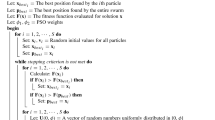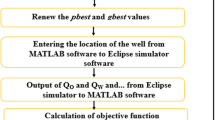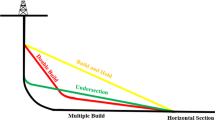Abstract
Proper well management requires the determination of characteristic hydraulic parameters of production wells such as well loss coefficient (C) and aquifer loss coefficient (B), which are conventionally determined by the graphical analysis ofstep-drawdowntest data. However, in the present study, the efficacy of a non-conventional optimization technique called Genetic Algorithm (GA), which ensures near-optimal or optimal solutions, is assessedin determining well parameters from step-drawdown test data. Computer programs were developed to optimize the well parametersby GA technique for two cases: (i) optimization of ‘B’ and ‘C’ only, and (ii) optimization of ‘B’, ‘C’ and ‘p’ (exponent) as well as to evaluate the well condition. The reliability and robustness of the developed computer programs were tested usingnine sets of published and unpublished step-drawdown data from varying hydrogeologic conditions. The well parameters obtained by the GA technique were compared with those obtained by the conventional graphical method in terms of root mean square error(RMSE) and visual inspection. It was revealed that the GA technique yielded more reliable well parameters with significantlylow values of RMSE for almost all the datasets, especially in caseof three-variable optimization. The optimal values of the parameters‘B’, ‘C’ and ‘p’ for the nine datasets were found to range from 0.382 to 2.292 min m-2, 0.091 to 3.262, and 1.8 to 3.6, respectively. Because of a wide variation of ‘p’, the GA techniqueresulted in considerably different but dependable and robust well parameters as well as well specific capacity and well efficiency compared to the graphical method. The condition of three wells was found to be ‘good’, one well ‘bad’ and that of the remaining five wells ‘satisfactory’. The performance evaluation of the developed GA code indicated that a proper selection of generation number and population size is essential to ensure efficient optimization. Furthermore,a sensitivity analysis of the obtained optimal parameters demonstrated that the GA technique resulted in a unique set ofthe parameters for all the nine datasets. It is concluded thatthe GA technique is an effective and reliable numerical tool for determining the characteristic hydraulic parameters of production wells.
Similar content being viewed by others
References
Batu, V.: 1998, Aquifer Hydraulics – A Comprehensive Guide to Hydrogeologic Data Analysis, John Wiley & Sons, New York, pp. 113–627.
Chang, F. I. and Chen, Li.: 1998, ‘Real-coded genetic algorithm for rule-based flood control reservoir management’, Water Resour. Manage. 12, 185–198.
Charbeneau, R. J.: 2000, ‘Groundwater Hydraulics and Pollutant Transport’, Prentice-Hall, Inc., New Jersey, pp. 91–178.
Cheng, A. H. D., Halhal, D., Naji, A. and Ouazar, D.: 2000, ‘Pumping optimization in saltwater-intruded costal aquifers’, Water Resour. Res. 36(8), 2155–2165.
Cieniawski, S. E., Eheart, J. W. and Ranjithan, S.: 1995, ‘Using genetic algorithms to solve a multiobjective groundwater monitoring problem’, Water Resour. Res. 31(2), 399–409.
Culver, T. B. and Shoemaker, C. A.: 1992, ‘Dynamic optimal control for groundwater remediation by differential dynamic programming with quasi-Newton approximations’, Water Resour. Res. 29(4), 823–831.
Deb, K.: 1998, Optimization for Engineering Design, PHI Private Limited, New Delhi, India, pp. 290–359.
Duan, Q., Sorooshian, S. and Gupta, V. K.: 1994, ‘Optimal use of the SCE-UA global optimization method for calibrating watershed models’, J. Hydrology 158, 265–284.
Freeze, A. R. and Cherry, J. A.: 1979, Groundwater, Prentice-Hall, Inc., New Jersey, pp. 60–382.
Gentry, R. W., Camp, C. V. and Anderson, J. L.: 2001, ‘Use of GA to determine areas of accretion to semi confined aquifer’, J. Hydraul. Engineer., ASCE, 127(9), 738–746.
Goldberg, D. E.: 1989, Genetic Algorithms in Search, Optimization and Machine Learning, Addison-Wesley Publishing Company Inc., New York, pp. 1–145.
Goldberg, D. E. and Deb, K.: 1989, A Comparative Analysis of Selection Schemes used in Genetic Algorithms, Foundations of Genetic Algorithms, Morgan Kaufman, San Mateo, CA, pp. 69–93.
Goulter, I. C.: 1992, ‘Systems analysis in water-distribution network design: From theory to practice’, J. Water Resour. Plann. Manage., ASCE, 118(3), 238–248.
Gwo, Jin-Ping: 2001, ‘In search of preferential flow paths in structured porous media using a simple genetic algorithm’, Water Resour. Res. 37(6), 1589–1601.
Hilton, A. B. C. and Culver, T. B.: 2000, ‘Constraint handling for genetic algorithms in optimal remediation design’, J. Water Resour. Plann. Manage., ASCE, 126(3), 128–137.
Holland, J. H.: 1992, Adaptation in Natural and Artificial Systems, MIT Press, 2nd ed., Cambridge, Mass., pp. 10–69.
Jacob, C. E.: 1947, ‘Drawdown test to determine effective radius of artesian well’, Transactions of ASCE 112, 1047–1070.
Jha, M. K., Chikamori, K., Kamii, Y. and Yamasaki, Y.: 1999, ‘Field investigations for sustainable groundwater utilization in the Konan basin’, Water Resour. Manage. 13, 443–470.
Jowitt, P. W. and Xu, Ch.: 1990, ‘Optimal valve control in water-distribution networks’, J. Water Resour. Plann. Manage., ASCE, 116(4), 455–472.
Khu, S. T., Liong, S. Y., Babovic, V., Madsen, H. and Muttil, N.: 2001, ‘Genetic programming and its application in real-time runoff forecasting’, J. Am. Water Resour. Assoc. 37(2), 439–450.
Labadie, J. W. and Helweg, O. J.: 1975, ‘Step-drawdown test analysis by computer’, Ground Water 13(5), 438–444.
Mayer, D. G., Belward, J. A. and Burrage, K.: 2001, ‘Robust parameter settings of evolutionary algorithms for the optimization of agricultural system models’, Agricul. Syst. 69, 199–213.
McKinney, D. C. and Lin, M. D.: 1994, ‘Genetic algorithm solution of groundwater management models’, Water Resour. Res. 30(6), 1897–1906.
Meier, R. W. and Barkdoll, B. D.: 2000, ‘Sampling design for network model calibration using genetic algorithms’, J. Water Resour. Plann. Manage., ASCE, 126(4), 245–250.
Miller, T. M. and Weber, W. J.: 1983, ‘Rapid solution of the nonlinear step-drawdown equation’, Ground Water 21(5), 584–588.
Mohan, S.: 1997, ‘Parameter estimation of nonlinear Muskingum models using genetic algorithm’, J. Hydraul. Engineer., ASCE, 123(2), 137–142.
Morshed, J. and Kaluarachchi, J. J.: 2000, ‘Enhancements to genetic algorithm for optimal groundwater management’, J. Hydraul. Engineer., ASCE, 5(1), 67–73.
Prasad, K. L. and Rastogi, A. K.: 2001, ‘Estimating net aquifer recharge and zonal hydraulic conductivity values for Mahi Right Bank Canal project area, India by genetic algorithm’, J. Hydrology 243, 149–161.
Ranjithan, S. and Eheart, J. W.: 1993, ‘Neural network-based screening for groundwater reclamation under uncertainty’, Water Resour. Res. 29(3), 563–574.
Reed, P., Minisker, B. S. and Goldberg, D. E.: 2000a, ‘Designing a competent simple genetic algorithm for search and optimization’, Water Resour. Res. 36(12), 3757–3761.
Reed, P., Minisker, B. S. and Valocchi, A. J.: 2000b, ‘Cost-effective long-term groundwater monitoring design using a genetic algorithm and global mass interpolation’, Water Resour. Res. 36(12), 3731–3741.
Ritzel, B. J. and Eheart, W.: 1994, ‘Using genetic algorithms to solve a multiple objective groundwater pollution containment problem’, Water Resour. Res. 30(5), 1589–1603.
Rizzo, D. M. and Dougherty, D. E.: 1996, ‘Design optimization for multiple management period groundwater remediation’, Water Resour. Res. 32(8), 2549–2561.
Rogers, L. L. and Dowla, F. U.: 1994, ‘Optimization of groundwater remediation using artificial neural networks with parallel solute transport modeling’, Water Resour. Res. 30(2), 457–481.
Rorabaugh, M. I.: 1953, ‘Graphical and theoretical analysis of step-drawdown test of artesian well’, Proc. Hydraul. Division, ASCE 79, 362-1–362-23.
Samuel, M. P.: 2002, ‘Determination of Aquifer and Well Parameters using Genetic Algorithm’, unpublished M. Tech. Thesis, Indian Institute of Technology, Kharagpur, India.
Savic, D. A., Walters, G. A. and Davidson, J. W.: 1999, ‘A genetic programming approach to rainfall-runoff modeling’, Water Resour. Manage. 13, 219–231.
Savic, D. A. and Walters, G. A.: 1995a, ‘Integration of a model for hydraulic analysis of water distribution networks with an evolution program for pressure regulation’, Microcomp. Civil Engineer. 10(3), 219–229.
Savic, D. A. and Walters, G. A.: 1995b, ‘An evolution program for optimal pressure regulation in water distribution networks’, Engineer. Optimiz. 24(3), 197–219.
Simpson, A. R., Dandy, G. C. and Murphy, L. J.: 1994, ‘Genetic algorithms compared to other techniques for pipe optimization’J. Water Resour. Plann. Manage., ASCE, 120(4), 423–443.
Smalley, J. B., Minsker, B. S. and Goldberg, D. E.: 2000, ‘Risk-based in situ bioremediation design using a noisy genetic algorithm’, Water Resour. Res. 36(10), 3043–3052.
Todd, D. K.: 1980, Groundwater Hydrology, John Wiley & Sons, New York, pp. 111–163.
Wang, Q. J.: 1991, ‘The genetic algorithm and its application to calibrating conceptual rainfall-runoff models’, Water Resour. Res. 27(9), 2467–2471.
Wardlaw, R. and Sharif, M.: 1999, ‘Evaluation of genetic algorithms for optimal reservoir system operation’, J. Water Resour. Plann. Manage., ASCE, 125(1), 25–33.
Yang, J. P. and Soh, C. K.: 1997, ‘Structural optimization by genetic algorithms with tournament selection’, J. Comput. Civil Engineer., ASCE, 11(3), 195–200.
Author information
Authors and Affiliations
Corresponding author
Rights and permissions
About this article
Cite this article
Jha, M.K., Nanda, G. & Samuel, M.P. Determining Hydraulic Characteristics of Production Wells using Genetic Algorithm. Water Resources Management 18, 353–377 (2004). https://doi.org/10.1023/B:WARM.0000048485.62254.1c
Issue Date:
DOI: https://doi.org/10.1023/B:WARM.0000048485.62254.1c




